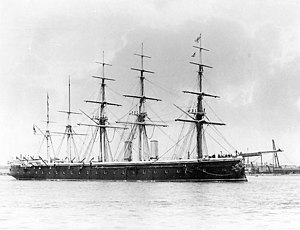Minotaur-class ironclad
 Minotaur, 1875–1887
| |
| Class overview | |
|---|---|
| Name | Minotaur class |
| Operators | |
| Preceded by | HMS Achilles |
| Succeeded by | Prince Consort class |
| Completed | 3 |
| Scrapped | 3 |
| General characteristics | |
| Class and type | Armoured frigate |
| Displacement | 10,627 long tons (10,798 t) |
| Length | 407 ft 0 in (124.05 m) (o/a) |
| Beam | 59 ft 6 in (18.1 m) |
| Draught | 27 ft 9 in (8.5 m) |
| Installed power |
|
| Propulsion | 1 shaft, 1 trunk steam engine |
| Sail plan | 5-masted |
| Speed | 14 knots (26 km/h; 16 mph) |
| Range | 1,500 nmi (2,800 km; 1,700 mi) at 7.5 knots (13.9 km/h; 8.6 mph) |
| Complement | 800 actual |
| Armament |
|
| Armour | |
The Minotaur-class ironclads consisted of three armoured frigates built for the Royal Navy during the 1860s. They were enlarged versions of HMS Achilles with heavier armament, thicker armour, and more powerful engines. The ships of this class were unique among ironclad warships in possessing on completion five masts, named fore-, second-, main-, fourth- and mizzen-.
History[]
They were originally intended to mount forty Armstrong 110-pounder breech-loading guns on the main deck, with ten more on pivot mountings on the upper deck. The failure of these guns in service led to a complete re-evaluation of their armament, with a concomitant delay in the arming of the whole class. The ships were armed with a combination of 9-inch muzzle-loading rifles (MLR) on metal carriages and 7-inch MLRs on rope-worked carriages. In a moderate swell these 7-inch guns were virtually unworkable, making the Minotaurs both the heaviest and the worst armed of the Victorian battleships.
The Minotaurs were poor sailors, never exceeding a speed under sail of about 9.5 knots (17.6 km/h; 10.9 mph) with all sail set and a favourable wind. They were, in spite of the number of masts they exhibited, the most sluggish of all British ironclads under sail. They were regarded as good sea-boats, and were considered to be among the steadiest ships in the battle-fleet[citation needed]. They were slow in manoeuvre under hand-steering, but were regarded as good after steam steering was fitted.
Notes[]
| Wikimedia Commons has media related to Minotaur class battleship. |
References[]
- Ballard, G. A., Admiral (1980). The Black Battlefleet. Annapolis, Maryland: Naval Institute Press. ISBN 0-87021-924-3.
- Brown, David K. (2003). Warrior to Dreadnought: Warship Development 1860–1905 (reprint of the 1997 ed.). London: Caxton Editions. ISBN 1-84067-529-2.
- Chesneau, Roger; Kolesnik, Eugene M., eds. (1979). Conway's All the World's Fighting Ships 1860–1905. Greenwich, UK: Conway Maritime Press. ISBN 0-8317-0302-4.
- Parkes, Oscar (1990). British Battleships (reprint of the 1957 ed.). Annapolis, Maryland: Naval Institute Press. ISBN 1-55750-075-4.
- Silverstone, Paul H. (1984). Directory of the World's Capital Ships. New York: Hippocrene Books. ISBN 0-88254-979-0.
- Text Book of Gunnery. London: Harrison and Sons for His Majesty's Stationery Office. 1887.
- Minotaur-class ironclads
- Ship classes of the Royal Navy